Fühlen Sie sich von den Möglichkeiten Ihres WordPress.com-Blogs eingeengt? Es ist, als würde man in einer Mietwohnung leben, in der man keine Änderungen vornehmen kann.
Aber stellen Sie sich vor, Sie ziehen in Ihr eigenes Haus – so ist es, wenn man von WordPress.com zu WordPress.org wechselt. Wenn Sie das Sagen haben, können Sie alle Entscheidungen treffen, und zwar von Grund auf.
Wir haben schon seit einiger Zeit alle unsere Websites auf WordPress.org aufgebaut. Aber wir haben auch unzählige Kunden bei diesem wichtigen Schritt begleitet. Jeder von ihnen hat uns gesagt, dass die neu gewonnene Freiheit es wert ist.
Sind Sie bereit, Ihren Blog in die leistungsstarke Website zu verwandeln, die Sie sich schon immer gewünscht haben? Wir führen Sie durch jeden einzelnen Schritt, damit Sie problemlos von WordPress.com zu WordPress.org migrieren können. Lesen Sie weiter, um zu erfahren, wie!

Warum von WordPress.com zu WordPress.org wechseln?
WordPress.com ermöglicht es jedem, einen Blog zu starten, indem er ein kostenloses Konto erstellt. Das macht es Anfängern leicht, schnell mit dem Bloggen zu beginnen, ohne sich mit technischen Fragen auseinandersetzen zu müssen.
Viele Benutzer stellen jedoch fest, dass ihr kostenloser WordPress.com-Blog einige Einschränkungen aufweist. Dazu gehören die begrenzte Möglichkeit, Geld zu verdienen, die Unmöglichkeit, Plugins zu installieren, Werbung von Drittanbietern, die den Benutzern angezeigt wird, und vieles mehr.
Aus diesem Grund wechseln die Benutzer häufig zur leistungsfähigeren und beliebteren selbst gehosteten Plattform WordPress.org. Alternativ können Sie auch ein Upgrade auf einen kostenpflichtigen WordPress.com-Tarif durchführen.
Wir haben WordPress.com und WordPress.org gründlich verglichen. In dieser Seite-an-Seite-Analyse werden die Unterschiede, Vor- und Nachteile der beiden Plattformen erläutert.
Wir empfehlen die Verwendung von WordPress.org, weil Sie damit die vollständige Kontrolle über Ihre Website und die Freiheit haben, alle Funktionen zu steuern. Um mehr über all diese Funktionen zu erfahren, lesen Sie unsere vollständige WordPress-Bewertung mit Vor- und Nachteilen.
Schauen wir uns also an, wie Sie Ihr Blog von WordPress.com zu WordPress.org migrieren.
Was Sie brauchen, bevor Sie anfangen
Um mit selbstgehostetem WordPress.org zu beginnen, benötigen Sie ein WordPress-Hosting-Konto und einen Domainnamen.
Wir empfehlen Bluehost, weil es eines der größten Hosting-Unternehmen der Welt und ein offiziell empfohlener WordPress Hosting-Anbieter ist.
Sie bieten WPBeginner-Benutzern auch einen kostenlosen Domainnamen und einen großen Rabatt auf Webhosting. Sie können für 1,99 $ / Monat beginnen (und dies beinhaltet auch kostenlose SSL).
Auch wenn Ihre WordPress-Website einen eigenen Domainnamen hat, benötigen Sie ein Webhosting. Melden Sie sich bei Bluehost an und fügen Sie unter dem Schritt „Domain“ Ihre Blog-Domain hinzu.
In den folgenden Schritten zeigen wir Ihnen, wie Sie beim Umzug von WordPress.com zu WordPress.org die gleiche Domain beibehalten können, ohne Suchergebnisse zu verlieren.
Neben dem Hosting-Konto benötigen Sie auch Zugang zu Ihrem WordPress.com-Konto, um Ihre Beiträge, Seiten, Bilder, Kommentare und andere Daten auf Ihre selbst gehostete WordPress Website zu übertragen.
Kostenloses Bonusangebot: Da viele von Ihnen danach gefragt haben, bieten wir jetzt einen kostenlosen Migrationsdienst von WordPress.com zu WordPress.org als Teil unseres kostenlosen WordPress-Blog-Einrichtungsdienstes an. Während dieses geführten Transfers wird eines unserer fachkundigen Teammitglieder die gesamte Migration für Sie durchführen (100% kostenlos). Das bedeutet, dass Sie ohne jedes Risiko von WordPress.com zu WordPress.org wechseln können.
Wenn Sie jedoch gerne lernen und die Dinge selbst in die Hand nehmen möchten, können Sie unserer Schritt-für-Schritt-Anleitung unten folgen. Hier finden Sie einen kurzen Überblick über alle Schritte, die wir behandeln.
- Step 1: Exporting Data From WordPress.com
- Step 2: Setting Up WordPress
- Step 3: Importing Content into a Self-Hosted WordPress Site
- Step 4: Importing Your Blogroll Links
- Step 5: Setting Your WordPress.com Blog to Private
- Step 6: Redirecting Visitors and Preserving SEO
- Video Tutorial
- Frequently Asked Questions (FAQs)
Los geht’s!
Schritt 1: Exportieren von Daten aus WordPress.com
Zuerst müssen Sie sich bei Ihrer WordPress.com-Website anmelden und zu Ihrem Konto-Dashboard gehen.
Von dort aus müssen Sie zur WP Admin-Anzeige für den Blog oder die Website wechseln, die Sie migrieren möchten. Klicken Sie einfach auf das Drei-Punkte-Menü neben dem Namen Ihrer Website und wählen Sie dann WP Admin.

Dies bringt Sie zum traditionellen WordPress-Dashboard.
Klicken Sie in der linken Spalte auf das Menü Extras “ Exportieren und dann auf die Schaltfläche „Alle exportieren“.
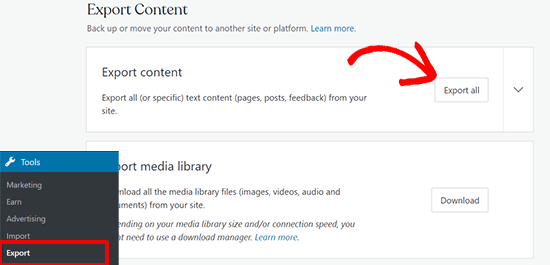
Damit können Sie Ihre WordPress-Website exportieren. Sobald die Exportdatei fertig ist, wird ein Download-Link angezeigt. Sie können darauf klicken, um die Zip-Datei auf Ihren Computer herunterzuladen.
WordPress.com sendet den Link auch per E-Mail an Ihre E-Mail-Adresse.
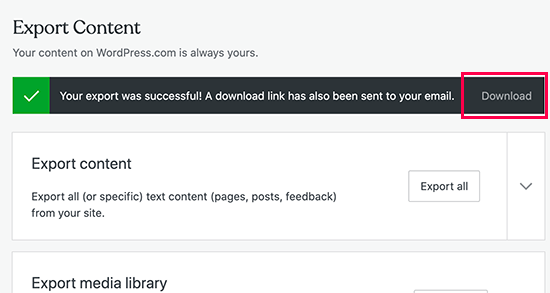
Sobald Sie die Datei auf Ihren Computer heruntergeladen haben, müssen Sie sie entpacken.
Darin finden Sie eine XML-Datei mit allen Ihren Beiträgen, Seiten, Bildern, Kommentaren, benutzerdefinierten Feldern, Kategorien, Tags, Navigationsmenüs und anderen Daten.
Schritt 2: WordPress einrichten
Nachdem Sie Ihre WordPress.com-Daten exportiert haben, müssen Sie nun eine neue WordPress-Installation auf Ihrem Webhosting einrichten.
WordPress ist sehr einfach zu installieren, und es sind nur ein paar Klicks nötig. Wenn Sie sich bei Bluehost angemeldet haben, wie wir oben erwähnt haben, wird WordPress automatisch für Sie installiert.
Wenn Sie sich für einen anderen Hosting-Service entscheiden, können Sie alternativ unsere Schritt-für-Schritt-Anleitung zur Installation von WordPress innerhalb von 5 Minuten befolgen.
Sobald Sie WordPress installiert haben, ist es an der Zeit, Ihre Inhalte in Ihre neue, selbst gehostete WordPress-Website zu importieren.
Schritt 3: Importieren von Inhalten in eine selbst gehostete WordPress-Website
Um den Inhalt Ihrer alten WordPress.com-Website in Ihre neue WordPress.org-Website zu importieren, müssen Sie sich in den Verwaltungsbereich Ihrer frisch installierten WordPress-Website einloggen.
Von hier aus müssen Sie die Seite Tools “ Importieren besuchen und auf die Schaltfläche „Jetzt installieren“ unter WordPress klicken.

WordPress wird nun den WordPress-Importer für Sie installieren.
Klicken Sie anschließend auf den Link „Importer ausführen“, um fortzufahren.
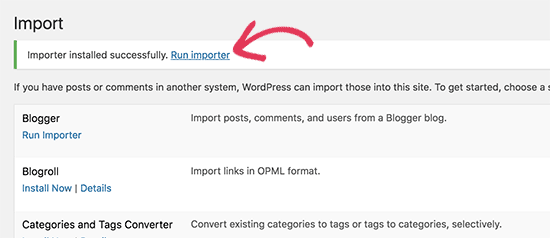
Sie werden zu einem Bildschirm weitergeleitet, auf dem Sie aufgefordert werden, die WordPress.com-XML-Datei hochzuladen, die Sie in Schritt 1 dieses Tutorials heruntergeladen haben.
Klicken Sie auf die Schaltfläche „Datei auswählen“, um die Datei auszuwählen, und klicken Sie dann auf die Schaltfläche „Datei hochladen und importieren“.
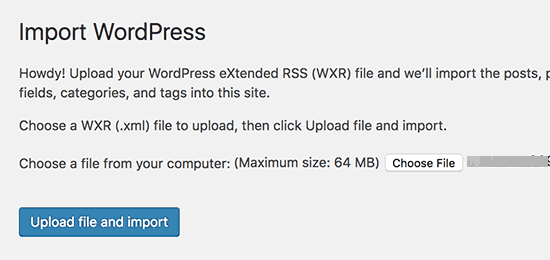
☝ Hinweis: Wenn Ihre Datei größer als 2 MB ist, haben Sie zwei Optionen. Zum einen können Sie Ihr Webhosting-Unternehmen bitten, das Limit vorübergehend zu erhöhen, damit Sie mit dem Prozess fortfahren können. Die andere Option besteht darin, Ihre Datei mit einem WXR-Dateisplitter zu teilen.
Wenn Sie mit dem Importieren beginnen, können Sie die importierten Inhalte einem vorhandenen Benutzer zuweisen oder einen neuen Benutzer anlegen.
Sie haben auch die Möglichkeit, Dateianhänge zu importieren. Sie müssen dieses Kästchen markieren, damit Ihre Bilddateien korrekt importiert werden.
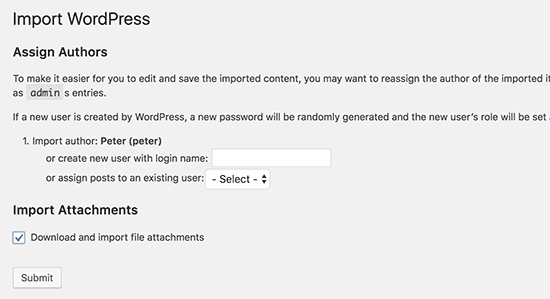
Schritt 4: Importieren Ihrer Blogroll-Links
Wenn Sie die Funktion Links in Ihrem WordPress.com-Blog verwendet haben, um Blogrolls oder andere Links zu speichern, müssen Sie diese Anweisungen befolgen, um sie zu importieren. Benutzer, die diese Funktion nicht verwendet haben, können mit Schritt 5 fortfahren.
WordPress unterstützt die Blogroll-Funktion nicht von Haus aus. Wenn Sie nicht zu viele Links in Ihrer Blogroll haben, lesen Sie unsere Anleitung, wie Sie Blogroll-Links in WordPress ohne ein Plugin hinzufügen können.
Wenn Sie jedoch zu viele Links haben oder die Blogroll-Funktionalität beibehalten möchten, dann lesen Sie weiter.
Blogroll-Links werden im OPML-Format exportiert. Dabei handelt es sich um ein XML-Format, mit dem Sie Ihre Links und Link-Kategorien exportieren und importieren können. Ihre WordPress.com-Links haben eine OPML-Datei, die sich an einer Adresse wie dieser befindet:
http://example.wordpress.com/wp-links-opml.php
Ersetzen Sie das Beispiel durch die Subdomain Ihres WordPress.com-Blogs.
Wenn Sie eine benutzerdefinierte Domain mit Ihrer WordPress.com-Website verwenden, können Sie auf Ihre OPML-Datei über eine URL wie die folgende zugreifen:
http://www.example.com/wp-links-opml.php
Ihre OPML-Datei wird in Ihrem Browser-Fenster geöffnet, und Sie müssen sie auf Ihrem Desktop speichern. Drücken Sie CTRL+S (Befehl+S auf Mac), um die Datei auf Ihrem Computer zu speichern.

Nachdem Sie nun ein Backup Ihrer WordPress.com-Links haben, müssen Sie diese in WordPress importieren. Selbst gehostetes WordPress verfügt jedoch nicht über einen standardmäßig aktivierten Linkmanager.
Sie müssen das Link Manager Plugin installieren und aktivieren. Auf der Seite des Plugins steht, dass es seit vielen Jahren nicht mehr aktualisiert wurde. Das liegt daran, dass es nicht aktualisiert werden musste, und Sie können dieses Plugin getrost installieren.
Nach der Aktivierung fügt das Plugin einen neuen Menüpunkt mit der Bezeichnung ‚Links‘ zu Ihrer WordPress Adminleiste hinzu.
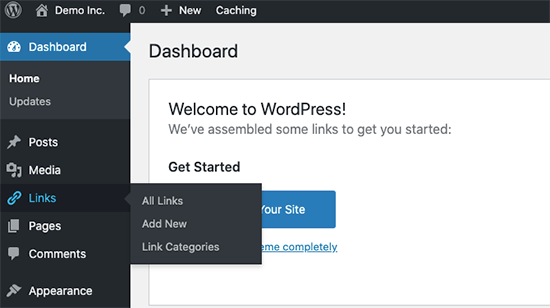
Als nächstes müssen Sie das OPML-Importer-Plugin installieren und aktivieren. Dieses Plugin aktiviert ein neues Importer-Tool, mit dem Sie Blogroll-Links importieren können.
Nach der Aktivierung müssen Sie die Seite Tools “ Importieren aufrufen und auf den Link „Importer ausführen“ unterhalb des Blogroll-Importers klicken.
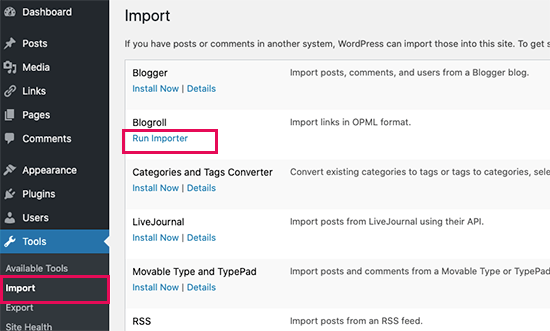
Auf der Seite des Blogroll-Importers müssen Sie die zuvor gespeicherte OPML-Datei hochladen.
Klicken Sie auf die Schaltfläche „Datei auswählen“, um die Datei auszuwählen, und klicken Sie dann auf die Schaltfläche „OPML-Datei importieren“, um fortzufahren.
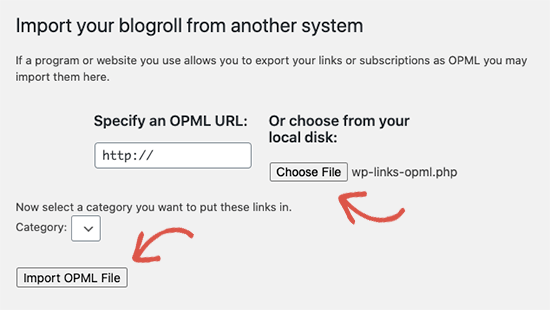
WordPress importiert nun Ihre Links und Link-Kategorien aus der OPML-Datei.
Sie können den Fortschritt sehen, und nach Abschluss wird eine Erfolgsmeldung angezeigt.

Schritt 5: Einstellen Ihres WordPress.com-Blogs auf privat
Wenn Sie Ihre alten Nutzer nicht auf Ihre neue Website umleiten wollen, ist dies der letzte Schritt.
Besuchen Sie zunächst das Dashboard Ihres alten Blogs auf WordPress.com. Klicken Sie im linken Menü auf Einstellungen “ Allgemein und scrollen Sie nach unten zum Abschnitt „Datenschutz“.

Wählen Sie hier die Option „Privat“ und klicken Sie dann auf die Schaltfläche „Einstellungen speichern“.
Dadurch wird Ihr altes WordPress.com-Blog privat und ist nur für Sie oder andere angemeldete Benutzer sichtbar, denen Sie zustimmen.
Achtung! Wenn Sie schon seit einiger Zeit schreiben und ein treues Publikum haben, dann ist es nicht sinnvoll, es hängen zu lassen.
Und wenn Ihr Blog schon eine Weile existiert, dann ist es wahrscheinlich, dass er von Google und anderen Suchmaschinen indiziert wird.
Sie können alle Suchmaschinenplatzierungen beibehalten und Ihre alten Nutzer einfach zu Ihrem neuen Blog umleiten, indem Sie Schritt 6 befolgen (sehr empfehlenswert, wenn Ihre Website bereits etabliert ist).
Schritt 6: Besucher umleiten und SEO beibehalten
Die Umleitung von Nutzern zum neuen Standort mit dem 301-Header ist eine Standardlösung, um Suchrankings zu erhalten, während eine Website von einem Ort zum anderen verschoben wird.
Da Sie keinen Zugriff auf die .htaccess-Datei auf WordPress.com haben, können Sie keine Änderungen vornehmen, um die Platzierung in den Suchmaschinen zu erhalten.
WordPress.com bietet jedoch eine kostenpflichtige Upgrade-Funktion namens „Site Redirect“ an, die diese Funktionalität bietet.
Gehen Sie einfach auf die Seite Site Redirect. Wenn Sie mehrere Websites auf WordPress.com haben, werden Sie gefragt, welche Sie umleiten möchten.
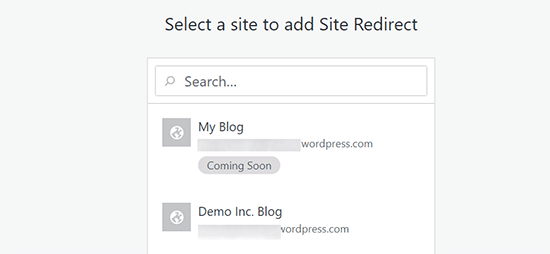
Auf dem nächsten Bildschirm werden Sie aufgefordert, den Domainnamen anzugeben, an den die Besucher weitergeleitet werden sollen. Geben Sie den Domainnamen Ihrer neuen WordPress.org-Website ein und klicken Sie auf die Schaltfläche „Los“.
Hinweis: Die Website-Weiterleitung ist ein kostenpflichtiges Upgrade und kostet $13 pro Jahr. Es fügt eine 301-Weiterleitung hinzu, die die Besucher Ihres WordPress.com-Blogs und die Suchmaschinen auf Ihre neue Website umleitet.
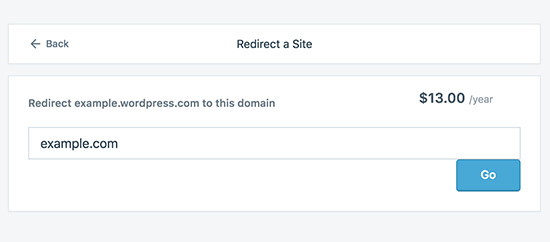
Einige von Ihnen werden sich fragen: Wie lange sollte ich für diese Offsite-Umleitungsfunktion bezahlen?
Die Antwort lautet: so lange Sie wollen. Zwei Jahre sind jedoch genug Zeit für Ihre alten Nutzer, um sich Ihren neuen Domänennamen einzuprägen.
Wenn Sie die Domäne wechseln, müssen Sie auch alle URLs in den Beiträgen aktualisieren. Wenn Sie Ihre Beiträge miteinander verlinkt haben, müssen diese Links aktualisiert werden. Sie können unseren Artikel über die Aktualisierung von URLs beim Umzug Ihrer WordPress-Website verwenden.
Wenn Sie eine individuelle Domain auf WordPress.com haben, müssen Sie sich keine Sorgen machen. Ändern Sie einfach den DNS-Eintrag bei Ihrem Hosts, und Sie behalten alle SEO-Vorteile.
Video-Anleitung
Möchten Sie den Prozess noch detaillierter sehen? Hier finden Sie eine Video-Anleitung, die Schritt für Schritt erklärt, wie Sie von WordPress.com zu WordPress.org migrieren:
Häufig gestellte Fragen (FAQs)
Wir haben die erste Version dieses Artikels im Januar 2013 geschrieben, also vor ziemlich langer Zeit! Aber wir aktualisieren ihn regelmäßig, um sicherzustellen, dass wir Sie mit den aktuellsten Informationen versorgen.
Seitdem haben wir eine Menge toller Fragen erhalten. Wir haben viele davon per E-Mail oder in Kommentaren beantwortet. Deshalb dachten wir, es wäre schön, die beliebtesten Fragen an einem Ort zusammenzufassen, wo sie jeder sehen kann.
Was passiert mit meinen WordPress.com-Abonnenten?
Glücklicherweise können Sie mit WordPress.com Ihre Abonnenten unter einer Bedingung migrieren. Sie müssen das Jetpack-Plugin verwenden, das Ihnen die gleiche Abonnentenfunktionalität wie bei WordPress.com bietet.
Sobald Sie das Jetpack Plugin installiert und aktiviert haben, müssen Sie das WordPress.com Team kontaktieren und es bitten, die Abonnenten für Sie zu migrieren. Wir hoffen, dass dies in den späteren Versionen von Jetpack einfacher wird und die Benutzer dies selbst tun können.
Können Sie mir helfen, kostenlos von WordPress.com zu WordPress.org zu wechseln?
Ja, natürlich. Wir bieten die Migration von WordPress.com als Teil unseres kostenlosen WordPress-Blog-Einrichtungsdienstes an. Wenn Sie unsere Hilfe benötigen, melden Sie sich einfach an. Es ist kostenlos ![]()
Wie hoch sind die Kosten für den Wechsel zu WordPress.org?
WordPress ist kostenlos. Es fallen jedoch einige minimale Webhosting-Kosten an. Wir empfehlen Ihnen, diesen Artikel zu lesen: Warum ist WordPress kostenlos? Was sind die Kosten und wo ist der Haken?
Ich habe bereits bei WordPress.com bezahlt. Kann ich eine Rückerstattung erhalten?
Ja, das können Sie. Wenn Sie vor kurzem eine benutzerdefinierte Domain oder einen kostenpflichtigen Plan von WordPress.com gekauft haben, können Sie eine vollständige Rückerstattung verlangen.
Hinweis: Domainregistrierungen können innerhalb von 48 Stunden nach der Registrierung storniert werden, und Pläne und andere Käufe können innerhalb von 30 Tagen nach dem Kauf storniert werden.
Werden meine Bilder kaputt gehen?
Nein, das werden sie nicht. Bei der Übertragung mit der Importdatei werden alle angehängten Bilder heruntergeladen, und der Link wird aktualisiert.
Wir haben jedoch eine Einschränkung festgestellt. Wenn die URL Ihrer Bilder mit files.wordpress.com beginnt, werden sie nicht konvertiert. Wenn Sie feststellen, dass sich die URL des Bildes nicht geändert hat und immer noch auf WordPress.com verweist, empfehlen wir Ihnen, das Plugin zum Importieren externer Bilder zu verwenden, das sich darum kümmert.
Ich habe meine Domain über WordPress.com registriert. Kann ich trotzdem umziehen?
Ja, das können Sie. WordPress ist der Meinung, dass die Nutzer die volle Kontrolle über ihre Inhalte haben sollten. Wenn Sie bereits einen Domainnamen über WordPress.com haben, brauchen Sie nur noch ein Webhosting-Konto.
Wir empfehlen, dass Sie sich bei Bluehost oder einem dieser anderen WordPress-Hosting-Anbieter einrichten. Während der Anmeldephase werden Sie gefragt, ob Sie eine Domain haben oder eine neue registrieren möchten.
Wählen Sie einfach die Option „Ich habe einen Domainnamen“ und geben Sie die Domain ein, die Sie bei WordPress.com registriert haben.
Als nächstes müssen Sie die Nameserver so ändern, dass sie auf den Hosting-Provider verweisen. Wir können Ihnen dabei im Rahmen unseres kostenlosen Einrichtungsdienstes helfen. Sie können auch Ihren Webhosting-Anbieter um Unterstützung bitten.
Wird meine Website beim Wechsel nicht mehr funktionieren?
Wenn Sie es richtig machen, dann NEIN. Die Methode, die wir oben vorgeschlagen haben, wird sicherstellen, dass Ihre Website niemals ausfällt. Wenn Sie sich Sorgen machen, dann wissen Sie, dass wir Ihnen helfen können. Sie können jederzeit unseren kostenlosen Einrichtungsdienst in Anspruch nehmen.
Kann ich meiner WordPress.org-Website einen Online-Shop hinzufügen?
Ja, Sie können Ihrer selbst gehosteten WordPress.org-Website problemlos und ohne zusätzliche Kosten einen Online-Shop hinzufügen. Da Bluehost und andere beliebte Webhoster kostenlose SSL-Zertifikate anbieten, müssen Sie lediglich ein WordPress-eCommerce-Plugin installieren, um einen Online-Shop hinzuzufügen.
Welche WordPress-Plug-ins sind ein Muss und welche empfehlen Sie?
Jetzt, da Sie zu selbst gehostetem WordPress.org gewechselt haben, können Sie so viele Plugins installieren, wie Sie möchten.
Hier ist unsere empfohlene Auswahl:
- AIOSEO – zur Verbesserung des SEO-Rankings Ihrer Website (wird von 3 Millionen Websites genutzt).
- WPForms – zum Hinzufügen eines intelligenten Kontaktformulars auf Ihrer Website (wird von 6 Millionen Websites verwendet).
- SeedProd – zum einfachen Anpassen Ihrer Landing Pages mit Drag & Drop Builder – funktioniert mit allen WordPress Themes.
- MonsterInsights – um zu sehen, wie Menschen Ihre Website finden und nutzen. Es ist ein Muss für Blogger und Kleinunternehmer.
- PushEngage – um mit Besuchern in Kontakt zu treten, nachdem sie Ihre Website verlassen haben.
- Duplicator – zur Erstellung täglicher Backups Ihrer neuen Website für den Notfall.
- OptinMonster – um Ihnen zu helfen, mehr E-Mail-Abonnenten zu bekommen und Ihre Bloggerreise erfolgreich zu gestalten.
Darüber hinaus empfehlen wir Ihnen einen Blick auf unsere Expertenauswahl der unverzichtbaren WordPress Plugins und nützlichen Werkzeuge für die Verwaltung und Erweiterung Ihres Blogs.
Sie können alle diese Plugins von Ihrem WordPress-Dashboard aus installieren. Wir haben eine Schritt-für-Schritt-Anleitung für die Installation eines WordPress Plugins erstellt.
Ich möchte das WordPress-Theme meiner Website ändern, kann ich das tun?
Ja, Sie können Ihr WordPress-Theme jederzeit ändern. Ein weiterer großer Vorteil des Wechsels zu WordPress.org ist, dass Sie zusätzliche Anpassungsmöglichkeiten und eine größere Sammlung von Themes zur Auswahl haben.
Klicken Sie in der Seitenleiste Ihrer WordPress-Verwaltung auf das Dropdown-Menü „Erscheinungsbild “ und wählen Sie „Themes“, um ein Theme zu installieren.
Wir haben einige der besten Themes ausgewählt, damit Sie nicht die Qual der Wahl haben. Sehen Sie sich unseren Leitfaden zu den besten kostenlosen Blog-Themes und den besten Mehrzweck-Themes für WordPress an.
Vielleicht interessiert Sie auch unsere Anleitung, wie Sie ein WordPress-Theme richtig ändern.
Wir hoffen, dass dieser Artikel Ihnen geholfen hat, Ihren Blog von WordPress.com auf WordPress.org umzuziehen. Vielleicht interessieren Sie sich auch für unsere Checkliste der wichtigsten Dinge, die Sie nach der Installation von WordPress erledigen müssen, und unseren ultimativen Leitfaden zur Steigerung der Besucherzahlen Ihres Blogs.
Wenn Ihnen dieser Artikel gefallen hat, dann abonnieren Sie bitte unseren YouTube-Kanal für WordPress-Videotutorials. Sie können uns auch auf Twitter und Facebook finden.





Inge
Hi,
I followed all the steps on the tutorial to move my already finished wordpress.com website to a wordpress.org website, using a new domain name and host. Everything seems to look exactly the same as on the video and it all seemed to work out, except at the very end… after importing the exported file from my wordpress.com to my wordpress.org, I do not see my website appear as I am used to when it was still a wordpress.com site… Instead I see a ‚hello world‘ page, in which it seems I have to start all over to make the website. Do I need to install a plugin for this? Is it costing me money eitherway to move my wordpress.com website to my own domain? (on which I installed WordPress?) It seems like the pages have imported succesfully, but I cannot see any content. No images, no text… Can anyone help me out?
Thank you!
Inge
Editorial Staff
Hi Inge,
This means that your import failed. We would be happy to help you if you still qualify for our free setup service.
Admin
WPBeginner Staff
Joe, we are sorry about that. Unfortunately JetPack likes are non-transferable.
Joe Johnston
I followed the instructions in this tutorial. I bought a domain name and hosting plan and transferred my wp.com blog there as per these instructions. I also purchased a 1 year site redirect. Everything worked, except for all the “likes“ that my posts use to have are no longer showing. I wish this tutorial would have mentioned that, as I would not have transferred my wp.com and paid for site redirect just to have a bunch of posts that look like they have never been liked by anybody. I’m really disappointed, particularly in jetpack and the whole wordpress system that everything can transfer except for the “likes“. It makes no sense…
WPBeginner Staff
Not if you are using the same domain with same permalink structure.
WPBeginner Staff
You can install WordPress on your own computer but you will not be able to access it using your domain name. For that you will have to move to a live server.
Terry
I have my domain, but no hosting yet. Can I build my wordpress.org site without having hosting in place already?
Gray
Hi there!
I just had a question that I cant quite find the answer to –
If you have a custom domain name on WordPress.com and change that domain over to .org, will it hold it’s place in Google rankings? And thus is there any need to pay for redirect?
Sorry if this is a silly question.
Ricardo P Aquino
I bet this is your most read article. Thank you for the post! I’m in the middle of this precise process myself and your website had ALL the knowledge I could possibly need to get it done.
Thank you!
WPBeginner Staff
No users will see a WordPress site with a hello world post. If you want you can put your self-hosted WordPress site in maintenance mode.
Emma
Hi! Question: I’m creating a new site for a client and they want to transfer their WordPress.com blog JUST to the „Blog“ page on a new WordPress.org site I’ve created for them. Will importing the wordpress.com xml file override all the work I’ve done to create the other pages on the WordPress.org site? Or is it possible to import the wordpress.com blog JUST for the new „Blog“ page?
WPBeginner Staff
Importing content into your self hosted WordPress.org site will not delete anything you have added to it before running the import.
Charles Cornelius
Thanks for the article, but I’m lost at step 3. I’m sure I’m being very dim.
I’ve done steps 1 and 2 Step 3 seems more of a leap, not a step, for me because clearly there’s more between steps 2 and 3 than meets the eye.
Firstly, where is my wordpress dashboard at my self-hosted site? (I’m using Blue Host and I have installed wordpress on to it – although in the cPanel it still has the option to install wordpress there). The wordpress dashboard isn’t on cPanel – presumably I have to get to it using mydomain.com/wp-admin, but does this mean I must first redirect the nameservers from wordpress.com to bluhost? (I’ve already got a domain for my site which wordpress.com redirects to).
Surely that means anyone visiting my site will see a blank page until I get the xml file uploaded and a theme installed.
So what are the substeps between steps 2 and 3?
WPBeginner Staff
Make sure your domain’s name servers are pointing to Bluehost and not to WordPress.com
You may also want to update site URLs.
Alex Ekkelenkamp
I’m having a bit of an issue. I’ve transferred my domain from WP.com to Bluehost, and installed WordPress. However, my admin link continues to bring me back to my wordpress.com dashboard as opposed to wordpress.org. Now my site is simply not loading at all. What have I done wrong?
Alex Ekkelenkamp
I’m feeling a little stuck, unfortunately. I’ve transferred my domain, installed WordPress on Bluehost, and accessed my dashboard. However, it is still the WordPress.com dashboard as opposed to WordPress.org. Not sure what went wrong!
WPBeginner Staff
You can retry, the importer is smart enough not to create duplicate content.
Laureen
I did a transfer from wordpress.com to wordpress.org over the weekend. I was able to export the content of the blog, but I noticed the other day not all of the comments transferred. Could this be a glitch? I selected „All Content“ on the export.
Saleem
Thank you for such a great article! I have a question. I have my own domain for my wordpress.com account, when I move to self hosting and get my domain to point to the new host will I keep my rank in the search on Google or have to build it up again? Thank you.
WPBeginner Staff
You will retain your rankings if your URL structure remains the same.
WPBeginner Staff
Yes, if the theme you are using is a free theme available to be used on self hosted WordPress sites.
Suzanne
I have a question. If I have subscribers and they automatically receive my blog updates, would I still have to do purchase a redirect? Would my subscribers not automatically get my new web address in the email. If they then respond via the email would it should go to the new site would it not?
thank you for your answer.
Suzanne
Harriet Southall
Hi there, I am going to go ahead with your free set up service to move our blog over – seems like a great service to me! I just wanted to check, will the blog layout and theme stay exactly the same as they are on the live site right now? The blog is thanks so much for your help!
WPBeginner Staff
Domain name and hosting are two different services. You can keep your WordPress.com domain name and use it with your self hosted WordPress site. Yes you can still benefit from our free blog setup service.
Cath
Such a great article! Love the illustration too!
I already have a domain name for my WP.com so I don’t need to buy one from your recommended providers. does this means I can not benefit from you free setup service?
Thanks!
Nick Moutvic
Hi, I had a question… I followed your directions and everything went smoothly. The only issue I have is something I’m not sure can even be helped. My new site has a new domain, however my original blog name is still mapped so whichever you type in the url bar it goes to the same place. I had a few viral posts on my old site and would like to keep the shares and views numbers, is there a way to do that? Essentially now the ones that had over 3K shares now say zero underneath the post. I’d like it to show its real share count.
WPBeginner Staff
Go to Appearance > Menus locate the menu item blog and expand to edit it. Make sure that the blog links to your blog page and not your WordPress.com site.
kash
I just need to get this right, So if i do the site redirect.. will all my links be redirected too. For eg.. say i text someone a link to a blog post.. in future if they click it.. will it automatically go to the new site and the post?
Jessica Barrett
I used this pages step by step instructions to try to migrate my wordpress.com blog over to the domain name and hosting I bought from godaddy.com. It crashed, and now my blog is completely gone. Godaddy claims it’s working just fine? There is no website anymore. When I type in my domain name it says that it’s unavailable. It’s 1:15 am, I’ve been at this all night, I need to work in the morning. I have worked my tail off on this blog for months. Now, does godaddy or wordpress reimburse me for losing my followers, reputation, countless hours, etc. and having to start completely over? I’ve never been so angry in my life.
WPBeginner Staff
Your posts should be safely stored at WordPress.com Unless you specifically deleted your old posts from WordPress.com.
vijetha
Hi,
I bought my domain name from wordpress.com a year ago, and I continued to blog with wordpress.com. Recently, with your post’s help, I moved to a self hosted option with blue host. I managed to trasnfer my domain name as well. I managed to transfer my content, images and even comments. I have 100 followers and statistics that I want to migrate to my current website. I know you said jetpack plugin is the only option but I tried activating the jetpack plugin and this is the error message I’m getting:
Jetpack could not contact WordPress.com: register_http_request_failed. This usually means something is incorrectly configured on your web host.
Operation timed out after 30233 milliseconds with 0 out of -1 bytes received.
I have tried getting in touch with the jetpack team and my web hosting people, but both of them are unable to help me out. Could you please tell me what can possible wrong and why I am not able to activate the jetpack plugin? Thanks.
WPBeginner Staff
You need to contact WordPress.com support to help you with migration. If you prefer to do it yourself then there is a subscription migration tool guide that you can follow.
WPBeginner Staff
Most of the steps will remain the same. Contact WordPress.com for transferring your subscribers. Likes cannot be transferred.
Monica
Hi,
So I have a WordPress.com account, and would like to switch to bluehost. However, I want to change my domain name to something different, but still keep my blog content and everything. Do I do these exact steps or is there something different since I’m switching names? And, do I install JetPack on my new site and THEN transfer my followers over from my old site? (since my wordpress.com does not have any plugins, I am unable to get them). I saw that my comments will transfer over after I do JetPack, however, do my likes transfer over as well?
Thanks!
WPBeginner Staff
Yes you will do step 1 to 3. Then work on your self hosted WordPress.org site until you are satisfied with it. After that you can do step 4 and 5.
Angela Mastrodonato
Hi! Thanks so much for the helpful tutorial. I know this is an old article, but if you have a chance, I was wondering if you could answer a question.
What if I want to copy my wordpress.com site to a self-hosted wordpress.org site, but I don’t want my domain to point to the wordpress.org site until I have updated the theme and tested it to make sure I am happy with it?
I want my visitors to go to the wordpress.com site until I am ready to direct them to the self-hosted wordpress.org site once I know the site looks and acts the way I want it to.
Would I pick a different option at step 4 (change wordpress.com site to private)? And if yes, what option would I pick?
And then what do I so when I am ready to point my domain to my self-hosted site? Do I simply pick „private“ in Step 4?
Thanks again!
WPBeginner Staff
Yes, if your WordPress.com site was on a custom domain, then the page rank should gradually move to new website.
Muhammad Qasim
HI
nice article
but in case wordpress.com site has page rank, page rank will also shift ?
Thanks
Syed Balkhi
You just need to setup Jetpack plugin and then ask their team to move your stats and subscribers.
Steve
Hi I have just transferred to .org from .com on WordPress. My question if anyone can help is that I had 94,300 „blog Stat hits“ on my .com platform and now that I have transferred I seemed to have lost them as the widget is not in the .org widget line up. I really wanted to keep these stats as it has been a great advert to my readers on my progress…I am lost as to what to do?
Cheers Steve
annie lee
hi, this wasn’t as easy as it seems i think i may have a problem. when bluehost asked if i have a domain or want to register a new one i clicked that i wanted to register a new one when in fact, i already have a paid/registered from wordpress.com and i know i can just redirect if only i have chosen the first option. will this be a problem??
i think i may have a problem. when bluehost asked if i have a domain or want to register a new one i clicked that i wanted to register a new one when in fact, i already have a paid/registered from wordpress.com and i know i can just redirect if only i have chosen the first option. will this be a problem??
WPBeginner Staff
Yes, we are.
Therese
Are you guys still doing this free setup service?
Amy Latta
This was all Enormously helpful! Thank you SO much for this simple, concise How To!
Amélie-Marie Le Boeuf
Thank you for this helpful article. I am planning to do the maneuver soon, but I am worried about it ! I have a question (maybe a stupid one!) regarding theme I bought for my wordpress.com. Will it work with a wordpress.org ? Not sure to be clear … thank you very much !
Donnet
I am trying to import my wordpress.com site to my wordpress.org site. I have followed all steps up to this point. I had a coder friend install wordpress into Gandi who I am hosting with and he also imported my .xml file to import all posts but my images are not saved in my media library even though they are in the posts. Another fault I ave seen is that my image captions have been saved as a part of the body of the post rather than as captions. I have tried to re-import the .xml file from my side at the backend of my wordpress.org site. I check the box to import attachments and choose to use my existing username account and click continue but then I get an ‚error 503 service unavailable‘ message after about 5min.
Any suggestions?
alistnz
I have successfully followed your tutorial and migrated my site from WordPress.com to WordPress.org. BUT there is a problem.
I transferred by FTP and your tutorial said to load the files in a directory called public_html
But now my domain is empty and my site only shows on the url http://www.mysite.com/public_html
Help?
WPBeginner Staff
Usually public_html is the root directory. However in your case it seems like you did not have a public_html directory. You need to repeat the process and this time upload WordPress files to your main root directory.
alistnz
Ok. So, if there is no public_html directory on the ftp server then you need to install direct to the root folder. Many thanks.
Helena
Thank you so so much for this tutorial. It worked flawlessly and I am strutting around feeling so proud of myself for transferring so seamlessly! Thank you for this resource!
Denise O'Meara
I just used this to successfully switch from wordpress.com to org in no time at all. Great post!
WPBeginner Staff
1. Depends on your theme, most WordPress.com themes are available for self hosted WordPress sites.
2. Please use contact form to reach us.
TK-Amsterdam
Ah ok, the theme is pinboard by Themify me (http://themify.me/themes/pinboard)
if you could double check for me, I ‚d be very thankful. I’ll contact via the contactpage for a waiting update..thanks
Tk-amsterdam
Hi, i’d like to use your free migrate service, and therefor register at bluehost. But before I have questions:
1 i purchased a theme template at wordpress.com…that will work on org as well?
2 is there a waiting list? How soon could you move it?
The site is parijsreis.nl
Thanks!
Char
Jetpack now has a migration tool to move subscribers from your wordpress.com to org! YAY. http://jetpack.me/support/subscription-migration-tool/
Ty for the info – this is my second blog to transfer and it went very smoothly. My first one was hellish and still some issues (that now I think I can fix with the plugins mentioned here)
Deandra Espagne
Hi, I’ve done the the switch from wordpress.com to wordpress.org but i’m having trouble import my old blog into this one. It keeps saying that the files already exist and I’m not sure what to do from there. Any help with that?
WPBeginner Staff
Nikki, if everything goes well then you would be able to continue blogging without any hiccups. To avoid these troubles, you can also check out our free blog setup service.
Tera N. Jade Greene
I would love to use this service… but it stinks that you force us to use one of your hosting sites. I have Godaddy. I enjoy godaddy and don’t want/need another host. Bummer!
Nikki@willrunforpizza.com
I’m completely new to all of this, but I’ve had my blog for a year now. I want to EVENTUALLY be able to do my own coding and change my theme, ads, fonts, colors, etc…as I learn. I just want to make sure that by switching from .com to .org, I’ll still have what I have NOW, and it won’t be a blank slate…Will I be able to just update and change things gradually once I move to .org?